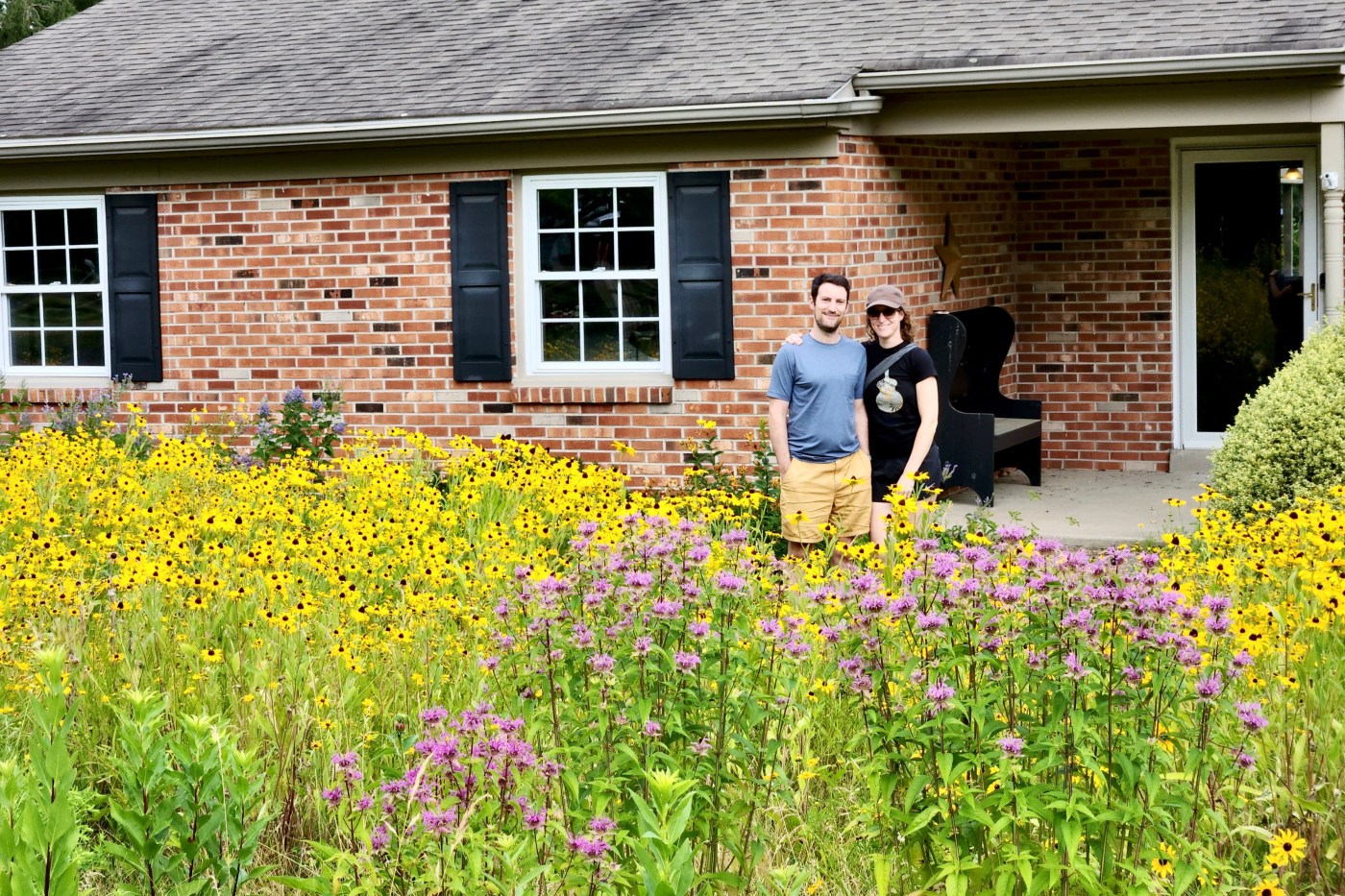
Can you get rid of your lawn without offending the neighbors?
What will the neighbors think?
It didn’t take long for that question to become front of mind when Sara Weaner Cooper and her husband, Evan Cooper, bought their first home, in Blue Bell, Pennsylvania, in the spring of 2022.
One question that answered itself right away: From the first pass with the mower over their 5,000 square feet of turfgrass, the couple knew that mowing a big lawn every week was not for them. But neither was the possibility of being seen as inconsiderate neighbors in their new community.
How could they reinvent their front yard without making an unwelcome impression?
This would be their first attempt at making a garden, but Sara Cooper was no stranger to the subject of lawn alternatives.
She has vivid memories from childhood of a backyard with “all these fun nooks in which to play, get lost in and explore.” That yard was the work of her father, Larry Weaner, a landscape designer in Glenside, Pennsylvania, for more than 40 years and a leader in the ecological landscape design movement in the United States.
Since 2019, Sara Cooper, 34, has been the executive director of New Directions in the American Landscape, an organization Weaner founded in 1990 to promote ecology-based landscape design and practice. There, she develops and coordinates educational programs, many for a professional audience.
But in response to increasing inquiries from lay people, she had an idea that will come to fruition in December, when the organization kicks off a multisession online course for home gardeners called Landscaping With Nature. Taught by Weaner, it is “a condensed, simplified version of our professional intensive course,” she said, complete with its own manual. (A short segment on her DIY front-yard project will be included; she is also doing a webinar about the yard adventure on Nov. 21.)
Cooper knew that most people don’t have a mentor they can text or call with questions the way she and her husband do. And right from the start there were questions — so many questions.
Like that one about the neighbors.
Avoiding a ‘Whole Brown Lawn’
An undated image by Sara Weaner Cooper of the sign that she and Evan Cooper posted to help neighbors understand meadow project, at their home Blue Bell, Pa. It isn’t easy or fast, but converting a grass yard into native meadow can be done. (Sara Weaner Cooper via The New York Times)
After some discussion with Weaner about possible designs, Cooper and her husband began visualizing a meadow in front of their house.
But they knew that preparing the site by getting rid of the grass — either using herbicides or solarization under plastic to kill it, or a sod stripper to remove it completely — would create “a whole brown lawn for a while,” Cooper said. Not a delightful sight for the neighbors.
Was there another tactical approach that was organic and also minimized the ugly phase, she and Evan Cooper asked Weaner?
He offered a suggestion, although it wasn’t his usual practice. “He said we could try seeding and planting into the existing turf, and just try to weaken the existing turf and strengthen the native plants,” Sara Cooper said.
This would be a bit of an experiment, they understood, and wasn’t the quickest means to an end.
“The things that we are doing are definitely a longer process than the maybe more conventional way of killing or removing the turfgrass first, and then just seeding or planting into bare soil,” she said.
As she and Evan Cooper were getting started in the fall of 2022, she took what proved to be another important preliminary step. She put out a lawn sign reading “Native Meadow in Progress” to communicate to neighbors that what they were about to see happening was intentional, not the beginning of a pattern of neglect. The sign invited questions and included her contact information.
Then the couple began their efforts to weaken the lawn and make it more receptive to what was coming — to the planned overseeding with meadow species and to young transplants of other types.
First, they applied sulfur to lower the pH of the underlying soil and bind nutrients to it, making the elements less available to vegetation. “The turfgrass needs fertility, and the meadow doesn’t,” Sara Cooper explained. “So that benefits the native meadow plants.”
They mowed the lawn short, and then had at it with a dethatcher, or power rake, rented from a local big-box store. “Basically, we disturbed the top layer of soil and disrupted the shallow root system of the turfgrass in order to thin out the grass,” she said. “That allows more light to reach the soil surface where the seeds will be, where we seeded eventually.”
Looking for signs of success
An undated image by Sara Weaner Cooper of Evan Cooper, left, and his father-in-law Larry Weaner transplanting a volunteer seedling of flowering dogwood (Cornus florida) at Cooper home Blue Bell, Pa. It isn’t easy or fast, but converting a grass yard into native meadow can be done. (Sara Weaner Cooper via The New York Times)
Seeding wouldn’t happen until the next January, following another round of dethatching. That first fall, they planted strategically placed drifts of live plants — some mixed groupings and others a mass of a single species, like blue wild indigo (Baptisia australis) and clustered mountain mint (Pycnanthemum muticum). The drifts of transplants would help shorten the waiting time before there was some visual payoff, flowering sooner than seed-grown choices.
After sowing, they waited and watched expectantly. And then: seedlings!
“It was so fun to see the first few things coming up,” Sara Cooper said. “It wasn’t a given.”
Identifying newly emerged seedlings, which don’t necessarily resemble the plant they will become, is not typically part of a beginning gardener’s skill set. But it was essential here, to make sure their efforts favored the keepers.
“The first thing that I saw that I knew wasn’t turfgrass turned out to be partridge pea,” Cooper recalled, referring to Chamaecrista fasciculata, an annual that eventually bears bright yellow flowers. She had seen it and thought, “That definitely looks different,” but didn’t know its name.
Who needs a plant-identification app when you have Larry Weaner in your virtual address book?
“I took a picture, and I sent it to my dad — that was my plant ID guide,” she said. “I said, ‘What is this?’ and he said, ‘Oh, my gosh. It’s partridge pea.’” Spoken like a proud grandfather.
Next to emerge and get a positive ID was another annual, lemon beebalm (Monarda citriodora). And the small triumphs continued, one after another.
An evolving mowing regimen
Once-a-year mowing, around the end of March, is now part of the care regimen for their increasingly established meadow. But along the way, the mower was called into service repeatedly in targeted maneuvers at key moments, cutting the growth to varying heights to further weaken the lawn in the evolving mix.
The couple cut the grass as short as possible with their electric mower around the drifts where the transplants were gradually getting established. Elsewhere, once the seeded plants started coming up through the turf, they needed to keep knocking back the grass without beheading the desired seedlings.
“The first year and this past second year, we needed to do that strategically timed mowing,” Cooper said. “I was able to adjust the mower higher and higher to just keep cutting that turfgrass, but not cut the seedlings. Once the seedlings got taller than the turfgrass, then obviously I stopped mowing.”
They also used a weed whip to give desired species an advantage in key spots.
Conversations with people and plants
Not long ago, Cooper was outside doing some yard work when she noticed a lawn-care service at work on a neighbor’s yard.
At the time, she was weed whipping the faded tops of some dandelions, “and the seeds were going everywhere,” she said. “Oftentimes, dandelions are associated with people letting their lawn go, not using herbicide to get rid of them. They are just a sign of lack of care.”
When some had begun to emerge in May in their meadow-in-the-making, she hadn’t gone after them aggressively. And even now, she was just doing a cosmetic edit, because she knew the natives would eventually outpace the dandelions.
“I was just so conscious of the juxtaposition of what I was doing and their nice lawn,” she said. “I realized that I want to explain to any neighbors that would ask, just to let them know that these dandelions are really temporary and they’re going to be outcompeted.”
She and Evan Cooper welcome talking about this new way of gardening, which is a kind of living discussion in itself — and not one conducted simply person to person.
“By better understanding the underpinnings of why a plant or a group of plants is behaving a certain way, it will inform the way that you converse with the land and the plants themselves,” Sara Cooper said. “It’s more of a conversation and less of just dictating our will on the garden, which is oftentimes what’s been done in the past.”
Recently, she and Evan Cooper removed a perimeter of invasive burning bush (Euonymus alatus) in the backyard, the first step in the next phase of their unfolding education.
“This isn’t just manipulating plants,” she emphasized. “It is engaging in a larger system of ecological processes.”
Related Articles
Biden sets a 10-year deadline for US cities to replace lead pipes and make drinking water safer
Hastings well tied to 3M ‘forever chemical’ pollution qualifies for settlement cleanup money
Food scrap pickup program expands to 19 new Washington County communities
Alaska resource projects and landscapes are again in the crosshairs of a presidential election
DNR plan to update Minnesota public waters list prompts concern over farmland


